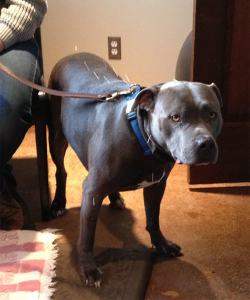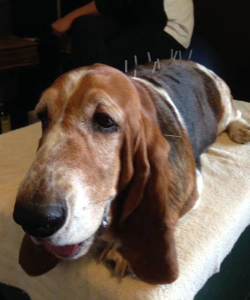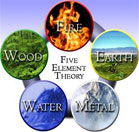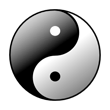Acupuncture
Acupuncture is the stimulation of specific points on the body which have the ability to alter various biochemical and physiological conditions in order to achieve a desired effect. Acupuncture has been practiced for nearly 4000 years on animals and humans and is the treatment of choice for one-quarter of the world’s population for many problems. It is now being utilized by an increasing population of veterinarians for various conditions. Acupuncture is known to influence all major physiological systems, working primarily through the central nervous system affecting the musculoskeletal, hormonal and cardiovascular systems. Acupuncture is performed by inserting a needle into a specific identified acupuncture point, located along its designated meridian. This results in increased blood flow or circulation, release of neurotransmitters and neurohormones, including endorphins, the bodies ‘natural pain-killing’ hormones. It can relieve muscle spasm, stimulate nerves and the body’s defense systems as well as having numerous other beneficial effects.
According to Chinese medicine theory, disease is the imbalance of energy or Qi (Chi) in the body. Qi is defined as the circulation of energy along well defined channels on the skin surface called meridians. These meridians connect internally to the organs, muscles, joint structures and the nervous system. Acupuncture therapy is based on the balancing of Qi which therefore allows the body to heal itself. Acupuncture is not to be considered a ‘cure all’, but can be effective as a sole means of therapy, or more commonly, as an adjunct to chiropractic and conventional western medicine. Acupuncture is commonly utilized when conventional medications are not working, are resulting in undesirable effects or where surgery is not feasible. It can be used as the only modality of treatment or can be combined with other forms of therapy, such as herbal remedies, nutrition and spinal manipulation. Acupuncture can be combined with conventional medicine and surgery in order to enhance the body’s response to treatment or manage pain post-operatively.
The following are some conditions that have been found to benefit from acupuncture:
- Musculoskeletal problems, including osteoarthritis, hip dysplasia, vertebral disc pathology
- Dermatologic problems such as allergic dermatitis and lick granulomas
- Respiratory problems such as asthma, rhinitis, chronic coughing or pneumonia
- Gastrointestinal problems, such as diarrhea or vomiting, inflammatory bowel disease, constipation
- Neurological disorders, including vestibular syndrome, nystagmus, torticollis, nondegenerative myelopathies and seizure
- Certain endocrine and reproductive disorders
- Urinary disorders including kidney failure, cystitis and incontinence
Is acupuncture painful and will my pet tolerate the treatment?
Acupuncture is most often performed with sterilized thin stainless steel needles. There is occasionally a brief moment of sensitivity as the needle penetrates the skin in certain sensitive areas. Once the needles are in place, most animals will become relaxed, often falling asleep during the treatment. Some animals with high levels of anxiety or fear may require more coaxing but they will often become increasingly more relaxed with subsequent treatments. Acupuncture is considered a safe form of medical treatment when performed by a properly trained veterinarian. Because acupuncture balances the body’s own system of healing and no chemicals are administered, complications rarely, if ever, occur. An animal’s condition may seem to deteriorate temporarily after an initial treatment – often 24-48 hours. This is an indication that some physiologic changes are occurring and this is most often followed by improvement of the animal’s condition.
How long and how often are acupuncture treatments?
The length and frequency of acupuncture treatments depends on the condition that is being treated. Acute cases may respond to one treatment, whereas chronic conditions may require several. Typically patients are treated 1-2 times weekly for 3-6 weeks, followed by every other week for several treatments. Then, pending on the case and outcome, ‘tune ups’ can be given on an as-needed basis. Treatments may last from 10 seconds to 30 minutes depending on the condition being addressed. There are different forms of acupuncture used including dry needling, aquapuncture (injecting a solution into a point), electroacupuncture, laser acupuncture and moxibustion (heating a point). Typically a combination of techniques are utilized for each case.
The TCVM Theory
Traditional Chinese Veterinary Medicine (TCVM) has been practiced for thousands of years and continues to evolve. It is a collection of healing modalities that when combined, synergistically can produce an overall balance in the body which in turn allows the body to heal itself. These modalities include acupuncture, herbal medicine, food therapy, tui na, feng shui and qi gong.
TCVM theory is based on a collection of concepts including Yin and Yang, the Eight Principles, the Five Elements and the Zang Fu organ systems of the body. TCVM involves treatment that creates the opposite condition that is diagnosed. Yin and Yang are the foundation to the principles of TCVM. The Eight Principles are an expansion of Yin and Yang and allow us to determine the location and severity of an animal’s imbalance. TCVM determines where the pathology is located – interior or exterior, how the body responds to the pathology – hot or cold, and whether the pathology is due to an excess or deficiency. Understanding the disease process in regards to the Eight Principles can help one determine the pattern diagnosis for each individual patient and therefore devise an appropriate treatment protocol. For example, an animal with orthopedic pathology (i.e. osteoarthritis) that is constantly seeking shade or prefers cool will likely have a Kidney Yin deficiency and excess Yang. In TCVM theory, the musculoskeletal system belongs to the kidney element. Treatment would include nurturing the Yin and kidneys through specific acupuncture points, as well as incorporating cooling foods and appropriate herbal remedies to assist in correcting the imbalance.
TCVM carefully examines the pulse quality and tongue characteristics to assist in determining a pattern diagnosis. Western medicine diagnostics can very much assist in evaluating each case and should be incorporated when devising any treatment protocol. The goals of western and eastern medicine are generally the same – to promote health and eliminate disease. Both systems have their strengths and weaknesses but when combined, health can be achieved. Western medicine can be quite effective when managing acute disease (i.e. fractured leg and surgical intervention), whereas eastern modalities can be more beneficial for chronic disease syndromes, especially when western medicine can only partially manage or not provide any benefit at all. Bridging the mental gap that is embedded in our minds and using both worlds to provide a better outcome is the primary goal when utilizing eastern modalities in a western world.




